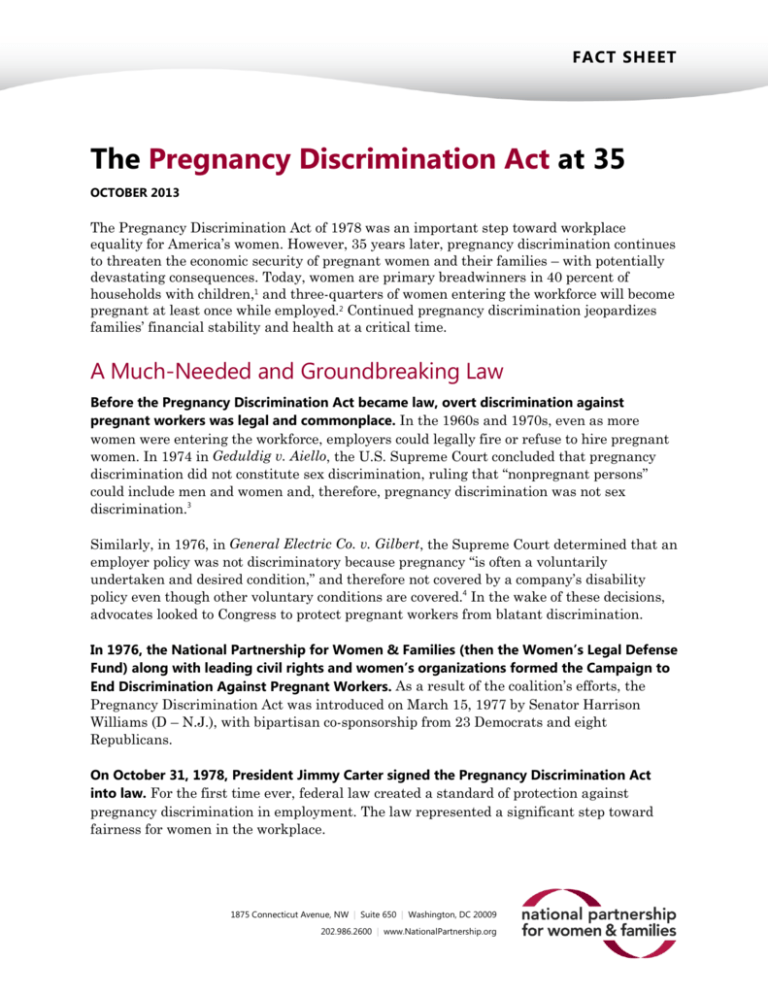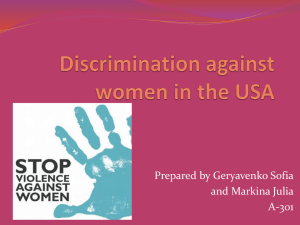
FACT SHEET
The Pregnancy Discrimination Act at 35
OCTOBER 2013
The Pregnancy Discrimination Act of 1978 was an important step toward workplace
equality for America’s women. However, 35 years later, pregnancy discrimination continues
to threaten the economic security of pregnant women and their families – with potentially
devastating consequences. Today, women are primary breadwinners in 40 percent of
households with children,1 and three-quarters of women entering the workforce will become
pregnant at least once while employed.2 Continued pregnancy discrimination jeopardizes
families’ financial stability and health at a critical time.
A Much-Needed and Groundbreaking Law
Before the Pregnancy Discrimination Act became law, overt discrimination against
pregnant workers was legal and commonplace. In the 1960s and 1970s, even as more
women were entering the workforce, employers could legally fire or refuse to hire pregnant
women. In 1974 in Geduldig v. Aiello, the U.S. Supreme Court concluded that pregnancy
discrimination did not constitute sex discrimination, ruling that “nonpregnant persons”
could include men and women and, therefore, pregnancy discrimination was not sex
discrimination.3
Similarly, in 1976, in General Electric Co. v. Gilbert, the Supreme Court determined that an
employer policy was not discriminatory because pregnancy “is often a voluntarily
undertaken and desired condition,” and therefore not covered by a company’s disability
policy even though other voluntary conditions are covered.4 In the wake of these decisions,
advocates looked to Congress to protect pregnant workers from blatant discrimination.
In 1976, the National Partnership for Women & Families (then the Women’s Legal Defense
Fund) along with leading civil rights and women’s organizations formed the Campaign to
End Discrimination Against Pregnant Workers. As a result of the coalition’s efforts, the
Pregnancy Discrimination Act was introduced on March 15, 1977 by Senator Harrison
Williams (D – N.J.), with bipartisan co-sponsorship from 23 Democrats and eight
Republicans.
On October 31, 1978, President Jimmy Carter signed the Pregnancy Discrimination Act
into law. For the first time ever, federal law created a standard of protection against
pregnancy discrimination in employment. The law represented a significant step toward
fairness for women in the workplace.
1875 Connecticut Avenue, NW | Suite 650 | Washington, DC 20009
202.986.2600 | www.NationalPartnership.org
The Pregnancy Discrimination Act amended Title VII of the Civil Rights Act of 1964 to
clarify that sex discrimination in employment includes discrimination on the basis of
pregnancy, childbirth, or related medical conditions.
Under the law, employers with 15 or more employees (including part-time and
temporary employees) cannot fire, refuse to hire, or deny a promotion to an employee on
the basis of pregnancy, childbirth or related medical conditions.
Furthermore, employers must treat pregnant workers the same way they treat workers
with other temporary illnesses, disabilities and medical conditions. This applies to all
employment policies, including benefit programs.
Despite Important Gains, Pregnancy Discrimination Persists
The Pregnancy Discrimination Act has given pregnant workers and federal enforcement
agencies a powerful tool with which to discourage and penalize pregnancy discrimination,
and the law has helped to change cultural norms about pregnant women in the workplace.
However, pregnancy discrimination persists.
Pregnancy discrimination complaints are actually on the rise, particularly among women
in lower-wage jobs and among women of color.5 From 1992 to 2011, the U.S. Equal
Employment Opportunity Commission (EEOC) reports that pregnancy discrimination
complaints increased by 71 percent.6
In addition, too many pregnant workers continue to endure discrimination because
employers refuse to make reasonable accommodations – such as allowing them to carry a
water bottle, take bathroom breaks or sit while providing customer service – that would
enable them to keep working. As a result, many women are forced out of their jobs even
though they are willing and able to work through their pregnancies.
Strengthening and Fulfilling the Promise of the Law
According to the most recent data, 62 percent of women in the United States who gave birth
in a one-year period also worked during that time.7 In fact, in every single state in 2012, the
majority of women who gave birth in a one-year period were also in the labor force.8 The
persistence of pregnancy discrimination in the workplace puts the financial stability and
health of these women, their babies and their entire families at risk.
The National Partnership for Women & Families supports policies and government actions to
curb pregnancy discrimination and fulfill the promise of the Pregnancy Discrimination Act,
including:
The Pregnant Workers Fairness Act (H.R. 1975/S. 942). Sponsored by Representative
Jerrold Nadler (D – N.Y.) and Senators Robert Casey (D – Pa.) and Jeanne Shaheen
(D – N.H.), and supported by a broad coalition of advocates, the Pregnant Workers
Fairness Act would build on the success of the Pregnancy Discrimination Act and
bring the nation closer to ending discrimination against pregnant workers while
strengthening the economic security of working families.
NATIONAL PARTNERSHIP FOR WOMEN & FAMILIES | FACT SHEET | THE PREGNANCY DISCRIMINATION ACT AT 35
2
The Pregnant Workers Fairness Act would put in place the same workplace
protections for women with pregnancy-related limitations as are in place for workers
facing similar limitations. This would essentially prevent employers from forcing
pregnant women out of the workplace and help to ensure that employers make
reasonable accommodations for pregnant women who want or need to continue
working.
Thorough and specific EEOC guidance for employers on best practices for complying
with the Pregnancy Discrimination Act and addressing pregnancy discrimination.
Enforcement of Pregnancy Discrimination Act compliance by federal contractors.
The U.S. Department of Labor’s Office of Federal Contract Compliance Programs
should update its regulations, training, compliance manual and enforcement
regarding pregnancy discrimination to help ensure that taxpayer dollars are not used
to subsidize unlawful discrimination.
Addressing the specific barriers faced by pregnant women in the federal workforce.
The U.S. Office of Personnel Management should not only promote nondiscrimination
in the federal workforce, but also serve as a model employer. The administration
should incorporate specific anti-discrimination protections in its own policies and
regulations.
Creation of a federal government task force to address the complex problem of
discrimination against pregnant women. An interagency task force could coordinate
efforts to improve employer compliance, workers’ understanding of their rights,
research and data collection, and litigation that benefits workers who are most at risk.
Thirty-five years after the Pregnancy Discrimination Act, it is well past time to end
pregnancy discrimination in this country and assure financial stability and workplace
opportunities for women at every stage of their lives.
1 Pew Research Center. (2013, May 29). Breadwinner Moms. Retrieved 26 July 2013, from http://www.pewsocialtrends.org/files/2013/05/Breadwinner_moms_final.pdf
2 Cawthorne, A., & Alpert, M. (2009, August 3). Labor Pains: Improving Employment and Economic Security for Pregnant Women and New Mothers. Center for American Progress
Publication. Retrieved 17 July 2013, from http://www.americanprogress.org/issues/women/report/2009/08/03/6599/labor-pains/
3 Geduldig v. Aiello, 417 U.S. 484, 496 n. 20 (1974).
4 General Electric Co. v. Gilbert, 429 U.S. 125, 136 (1976).
5 National Partnership for Women & Families. (2008, October). The Pregnancy Discrimination Act: Where We Stand 30 Years Later. Retrieved 16 July 2013, from
http://www.nationalpartnership.org/site/DocServer/Pregnancy_Discrimination_Act_-_Where_We_Stand_30_Years_L.pdf
6 U.S. Equal Employment Opportunity Commission. (2012). Pregnancy Discrimination Charges. Retrieved 22 October 2013, from
http://www.eeoc.gov/eeoc/statistics/enforcement/pregnancy-a.cfm and http://www.eeoc.gov/eeoc/statistics/enforcement/pregnancy.cfm
7 U.S. Census Bureau. (2013). American Community Survey 1 Year Estimates, Geographies: All States within United States, Table B13012: WOMEN 16 TO 50 YEARS WHO HAD A
BIRTH IN THE PAST 12 MONTHS BY MARITAL STATUS AND LABOR FORCE STATUS
Universe: Women 16 to 50 years, Retrieved 22 October 2013, from
http://factfinder2.census.gov/faces/tableservices/jsf/pages/productview.xhtml?pid=ACS_12_1YR_B13012&prodType=table. National Partnership for Women & Families
calculation based on the total of unmarried and married women who have had births in the past 12 months who are in the labor force divided by the total number of women
who have had a birth in the past 12 months.
8 Ibid.
The National Partnership for Women & Families is a nonprofit, nonpartisan advocacy group dedicated to promoting fairness in the workplace, access to quality health care and
policies that help women and men meet the dual demands of work and family. More information is available at www.NationalPartnership.org.
© 2013 National Partnership for Women & Families. All rights reserved.
NATIONAL PARTNERSHIP FOR WOMEN & FAMILIES | FACT SHEET | THE PREGNANCY DISCRIMINATION ACT AT 35
3





